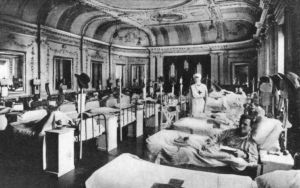|
|
| Home Topics Memorials Miscellany Transcripts References Family History Glossary Latest Beeston Blog About us | Site Search |
|
Charles Harold Thorpe was born in Beeston in 18781, the eldest of three children born to Charles & Mary Thorpe. Charles senior was born in Ruddington and had worked as a railway labourer after he came to Beeston in the 1880s to live with his widowed mother and his siblings2. Soon after that, in about 1890, it appears that he married Mary, Charles Harold being born soon after. Over the next ten years, the family appear to have lived for a short time in Bulwell, where their second son, John William was born in 1894. However, by 1897 they had returned to Beeston, where their daughter Matilda was born. By 1901, the family were living at 34 Chapel Street, Beeston with Charles senior working as a Shetland shawl maker3. By 1911, the family had moved to 21 Gladstone Street, Beeston with Charles senior still working as a shawl maker and all three children now working. Charles Harold had found work as core maker with a railway wagon maker4. It seems that soon after the outbreak of war, in August 1914, Charles Harold enlisted with the Royal Field Artillery and was posted to the 47th Brigade5. After initial training in England, the Brigade was organised into four four-gun batteries - A, B, C & D Batteries. Bombardier Thorpe became part of 'C' Battery. The Brigade left Southampton in the morning of 20th May 1915, went ashore in Havre on the 22nd, traveled by train to St Omer and marched to billets nearby. Over the following weeks the Brigade moved into Flanders where the batteries were variously deployed in actions at Hooge and the Ypres Salient during which Bombardier Thorpe would have experienced heavy shelling and gas attacks. At some point during this fierce fighting, Bombardier Thorpe was seriously injured6 and was repatriated to England where he was admitted to Bishops Knoll Hospital in Bristol.
Despite all efforts by the staff at Bishops Knoll Hospital, Bombardier Thorpe died there on 18th October 19158. His body was returned to Beeston where he was buried at Wollaton Road Cemetery. His memorial is one of 46 in the cemetery, from all wars, which are maintained by the Commonwealth War Graves Commission. Footnotes 1His birth was registered in Q3/1890 in Basford Registration District (which includes Beeston), Ref 7b 141. 21891 Census - Piece 2671 Folio 122 - 53 Queens Road, Beeston, Notts. 31901 Census - Piece 3153 Folio 97. 41911 Census - Piece 20428 RD429 SD3 ED6 Sched 259. 5Unfortunately, Bombardier Thorpe's Army Service Record does not appear to have survived. Assumptions as to the detail of his service have therefore beeen derived from the War Diary of 47th Brigade, Royal Field Artilliary, in so far as it refers to 'C' Battery, to which he was attached. This appears to survive, during thus period, up to 21st July 1915 (see www.1914-1918.net/Diaries/wardiary-47BdeRFA.htm ). 6The surviving War Diary records that two (unnamed) Bombardiers, apparently from 'C' Battery, were injured on 20 July 1915 while laying telephone at Hell Fire Corner and the Menin Road generally. It is not known whether Bombardier Thorpe was one of these or whether he was injured later. 7There is more on the life of Robert Edwin Bush, including detail of his early life as a First Class cricketer and friend of W G Grace and his achievements in later life, at https://en.wikipedia.org/wiki/Robert_Edwin_Bush. 8His death was recorded in Bristol Registration District, Q4/1915, Ref 6d 300. |
|
|||||||||||
|
|
|||||||||||||

 Robert Edwin Bush was a Bristol man who had spent 30 ultimately successful years as a sheep farmer in Australia. He had returned to England in the early 1900s with a considerable fortune, part of which he
had used to acquire Bishop's Knoll, a large house, set on a hill in Stoke Bishop. At the outbreak of war, he immediately converted the house to serve as a military hospital, at considerable personal cost. He
and his family moved in a cottage in the grounds and he himself worked as an ambulance orderly. His initial intention was that it was to be used for the care of sick and wounded Commonwealth soldiers but,
after some disagreement over the need for Australian staff for Australian troops, the hospital opened for all Allied troops, before taking Australians only from 1916 onwards. It was to become a very
successful hospital which was highly rated amongst those who were sent there. Pictured left is Ward 1 of the hospital which was set up in the former Music Room7
Robert Edwin Bush was a Bristol man who had spent 30 ultimately successful years as a sheep farmer in Australia. He had returned to England in the early 1900s with a considerable fortune, part of which he
had used to acquire Bishop's Knoll, a large house, set on a hill in Stoke Bishop. At the outbreak of war, he immediately converted the house to serve as a military hospital, at considerable personal cost. He
and his family moved in a cottage in the grounds and he himself worked as an ambulance orderly. His initial intention was that it was to be used for the care of sick and wounded Commonwealth soldiers but,
after some disagreement over the need for Australian staff for Australian troops, the hospital opened for all Allied troops, before taking Australians only from 1916 onwards. It was to become a very
successful hospital which was highly rated amongst those who were sent there. Pictured left is Ward 1 of the hospital which was set up in the former Music Room7